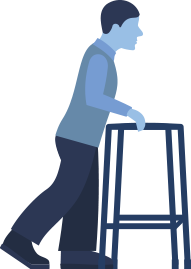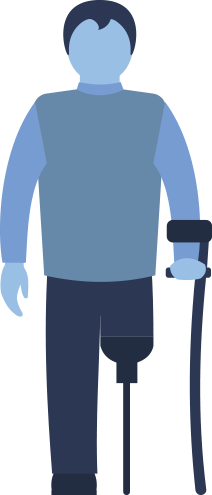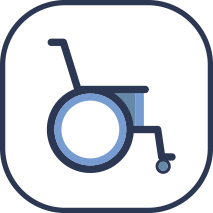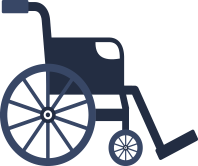
What is disability insurance?
Per the U.S. Social Security Administration, around one in four 20-year-olds will become disabled before they retire. That’s kind of scary, but there’s some good news at least there is a safety net, Long-term and short-term disability insurance protects your paycheck if you can’t work due to illness or injury.
There are actually two types of disability insurance. Short-term disability insurance replaces a portion of your paycheck for a short period of time. Think three to six months. Most people get STDI through their employer.
Long-term disability insurance (LTD, on the other hand, provides coverage if you’re out of work for a longer period of time. Think years or even decades. It, too, is sometimes offered by employers, but the benefit is less common.
Some GOOD NEWS for disability insurance:
We recommend a non-cancelable and guaranteed renewable policy (sometimes only available as a rider, which allows means that the insurer can’t change the terms of your policy (including the premium rate, as long as the premiums are paid. “Guaranteed renewable” means your policy can’t get canceled so long as your premiums are paid, meaning the only person in theory that can cancel it is the paying person or individual.


Disability Insurance Policy Types?
Own occupation disability insurance: This policy defines a disability as the inability to work at your regular occupation, even if you still might be able to work at another occupation. For example, a surgeon with hand tremors who takes a job as a medical school lecturer would be eligible for benefits under an own occupation policy because he can’t perform the duties of his own occupation. Any occupation disability insurance: To qualify as disabled under this policy, you must be unable to work at any occupation. This is a harder policy to claim benefits from, but it’s also usually less expensive than an own occupation policy.
1. File a disability claim
An Long Term Disability claim generally requires information about your job and diagnosis (usually statements and documents from your physician. The insurance company will review the claim and either approve it, request more information, or deny it as appropriate.2. Wait out the elimination period.
All Long Term Disability policies require a claimant remain disabled for a period of time between when the disability begins and the benefit payments start. (Otherwise, short-term disability insurance applies. Most commonly, these periods are 30, 60 or 90 days, but there are longer waiting periods of 180 and 365 days also available. Typically, the longer the elimination period, the lower the premiums. Just remember, you’ll have to cover costs out-of-pocket until coverage kicks in.

3. Receive your benefits.
Once a disability claim is approved and the elimination period expires, you’ll receive your monthly benefit for as long as your disability lasts, for up to the defined “benefit period.” Companies provide benefit periods as short as two years and as long as right up to retirement age (67, when Social Security benefits would take over.4. Return to work when you’re able.
Payments end if and when you can fully return to your regular occupation. However, depending on your policy and/or the riders you purchases, you can sometimes still collect benefits if you can return to your regular occupation in a limited capacity or only work in a different occupation.

How Much Does Disability Insurance Cost?
It depends. Long-term disability premiums are based on age, gender, occupation and features, but you can generally expect to pay between 1% to 3% of your annual salary for a policy. Remember, you’ll want the benefit amount to cover you if you’re out of work for an extended period. The good news here, though: When you buy an Long Term Disability policy (as opposed to signing up for one offered by an employer, the benefits aren’t taxed. That means a policy that pays out 60% of your gross income would effectively replace most of your take-home paycheck.
What exactly is short-term disability insurance?
Short-term disability insurance is an insurance product that replaces your income for a short period of time in the event that you experience a disability. The benefit period usually lasts 3 to 6 months. A disability is any medical condition that stops you from working. It’s a common misconception that disabilities only occur because of workplace accidents; in fact, most disabilities are caused by chronic conditions like back injuries, cancer, and heart disease. Depending on your employer, pregnancy may also be categorized as a disability, and you may need to use a disability insurance policy to provide income while you’re on leave from work.
STDI plans typically cover up to 80% of your gross income.
Short-term disability insurance vs. long-term disability insurance
Long-term disability insurance (or LTD insurance has the same purpose as short-term disability insurance. The difference is when it kicks in and for how long. Long-term disability insurance only kicks in after an elimination period (a.k.a. a waiting period. The typical elimination period is 90 days, but can be as long as 180 or 360 days depending on your policy. As you can probably already tell, short-term disability and long-term disability are designed to be used in tandem. While long-term disability doesn’t kick in for three to six months, it can last for years. The average long-term disability claim lasts for 35 months. While some employers offer long-term disability as well as short-term disability, it may make more sense to buy a private long-term disability policy that sticks with you from job to job.
Recommendation Recap
While specifics vary from case to case, our Geniuses generally recommend the following features for a long-term disability policy. An untaxed monthly benefit of approximately 60% of your total gross income and close to your take-home pay. A 90-day elimination period between the start of your disability and the receipt of your first check. An own occupation policy, which defines a disability as the inability to work at your regular occupation, even if you still can work at another occupation. A non-cancelable, guaranteed renewable policy so your premiums are locked in and your policy isn’t up for cancellation. A benefit period to age 67, meaning if you get permanently disabled from working in your 30s, you’ll be covered until 67 when your retirement benefits take over. Residual disability coverage, which pays benefits if you can work some time but not all of the time due to a disability. (It covers the partial loss of income with a partial payout of your disability benefit.
What alternatives are there to short-term disability insurance?
The best alternative to short-term disability insurance is to self-insure with an emergency savings fund. Most financial experts suggest that you have an emergency fund of anywhere between three and six months salary anyway, which, combined with an LTD policy, can easily cover you during a disability.
